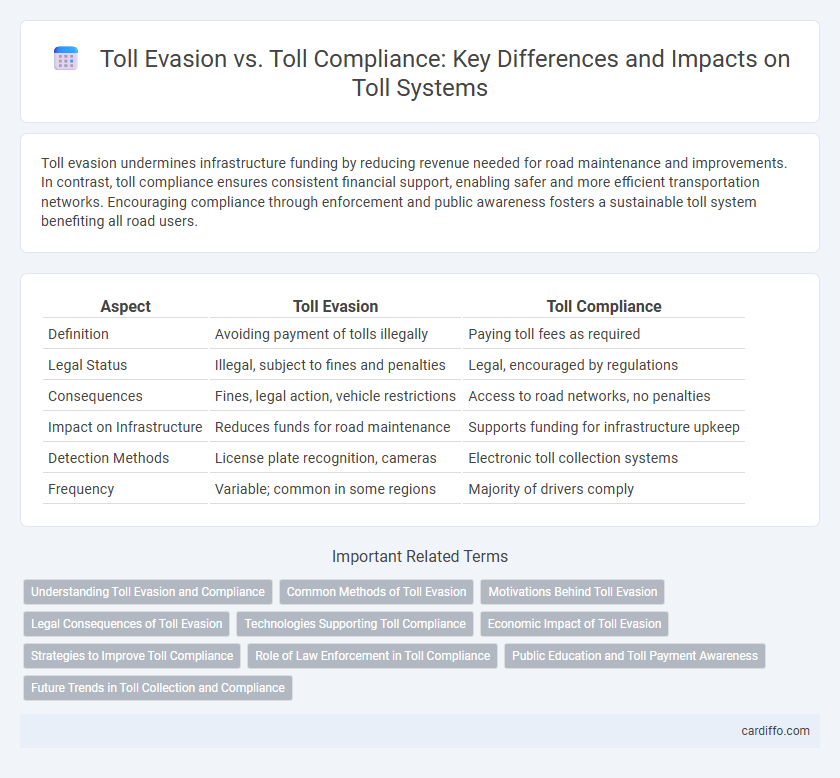Toll evasion undermines infrastructure funding by reducing revenue needed for road maintenance and improvements. In contrast, toll compliance ensures consistent financial support, enabling safer and more efficient transportation networks. Encouraging compliance through enforcement and public awareness fosters a sustainable toll system benefiting all road users.
Table of Comparison
| Aspect | Toll Evasion | Toll Compliance |
|---|---|---|
| Definition | Avoiding payment of tolls illegally | Paying toll fees as required |
| Legal Status | Illegal, subject to fines and penalties | Legal, encouraged by regulations |
| Consequences | Fines, legal action, vehicle restrictions | Access to road networks, no penalties |
| Impact on Infrastructure | Reduces funds for road maintenance | Supports funding for infrastructure upkeep |
| Detection Methods | License plate recognition, cameras | Electronic toll collection systems |
| Frequency | Variable; common in some regions | Majority of drivers comply |
Understanding Toll Evasion and Compliance
Toll evasion involves deliberately avoiding toll payments, undermining infrastructure funding and increasing enforcement costs. Toll compliance ensures consistent revenue for maintenance and development of transport networks, promoting fairness and efficiency. Understanding the motivations and methods behind toll evasion helps in designing effective compliance strategies and technology solutions.
Common Methods of Toll Evasion
Common methods of toll evasion include using counterfeit or cloned transponder devices, deliberately driving through toll points without activating payment systems, and exploiting malfunctioning or poorly monitored toll booths. Some drivers opt for unregistered vehicles or use license plate covers to avoid detection by automated cameras. These tactics significantly reduce toll revenue and undermine the effectiveness of electronic toll collection systems.
Motivations Behind Toll Evasion
Financial savings and lack of enforcement drive many drivers to evade tolls, viewing compliance as an avoidable expense. Limited awareness about toll regulations and perceived low risk of penalties further motivate non-compliance. Psychological factors, such as mistrust in toll authorities and resistance to paying fees, also contribute significantly to toll evasion behavior.
Legal Consequences of Toll Evasion
Toll evasion results in significant legal consequences, including fines, penalties, and potential criminal charges depending on jurisdictional laws. Authorities often implement automated enforcement technologies, such as license plate recognition systems, to identify toll violators and ensure compliance. Strict legal measures and enforcement aim to discourage toll evasion and promote adherence to toll payment regulations, safeguarding infrastructure funding and transportation system efficiency.
Technologies Supporting Toll Compliance
Advanced technologies such as RFID transponders, automated number plate recognition (ANPR), and GPS-based tolling systems significantly enhance toll compliance by enabling accurate and seamless vehicle identification and payment processing. Electronic toll collection (ETC) systems reduce human error and prevent toll evasion by enforcing real-time billing and monitoring of all passing vehicles. Integration of AI-driven analytics further improves detection of suspicious patterns, ensuring stricter enforcement and higher revenue recovery from toll operations.
Economic Impact of Toll Evasion
Toll evasion leads to significant financial losses for governments, reducing funds available for road maintenance and infrastructure development. This shortfall increases the economic burden on compliant drivers through higher toll rates and taxes, distorting transportation budgets. Persistent toll evasion undermines investment in transportation networks, ultimately affecting economic growth and public safety.
Strategies to Improve Toll Compliance
Implementing advanced electronic toll collection systems with real-time monitoring significantly reduces toll evasion by automating payment processes and minimizing human error. Integrating data analytics to identify high-risk evasion patterns allows authorities to target enforcement efforts more effectively and optimize resource allocation. Enhancing public awareness campaigns about legal consequences and providing convenient payment options encourages voluntary toll compliance and reduces delinquency rates.
Role of Law Enforcement in Toll Compliance
Law enforcement plays a critical role in ensuring toll compliance by conducting regular checkpoints and monitoring toll plazas with advanced surveillance technologies. Strict penalties imposed by authorities on toll evasion serve as a deterrent, reinforcing lawful payment behavior among drivers. Collaborative efforts between law enforcement agencies and toll operators enhance the efficiency of toll collection systems and reduce revenue losses caused by toll evasion.
Public Education and Toll Payment Awareness
Public education campaigns significantly improve toll payment compliance by raising awareness about legal obligations and penalties associated with toll evasion. Informative initiatives highlighting the benefits of toll compliance, such as infrastructure maintenance and reduced traffic congestion, motivate drivers to pay accurately and on time. Enhanced understanding of electronic toll collection systems through targeted outreach further reduces violations and fosters a culture of responsible road use.
Future Trends in Toll Collection and Compliance
Future trends in toll collection emphasize the integration of advanced technologies such as AI-powered license plate recognition, blockchain-based payment systems, and real-time data analytics to enhance toll compliance and reduce evasion. Automated, contactless tolling systems coupled with mobile payment platforms facilitate seamless transactions, minimizing human error and fraud risks. Increased government regulations and innovations in vehicle-to-infrastructure communication will further promote transparency and accountability in toll management.
Toll evasion vs toll compliance Infographic

 cardiffo.com
cardiffo.com